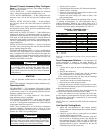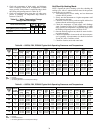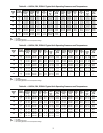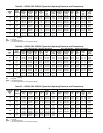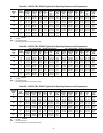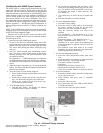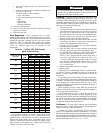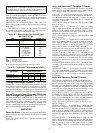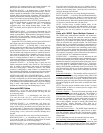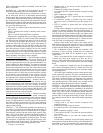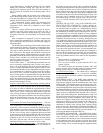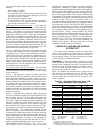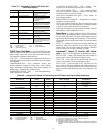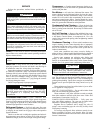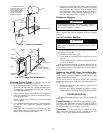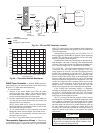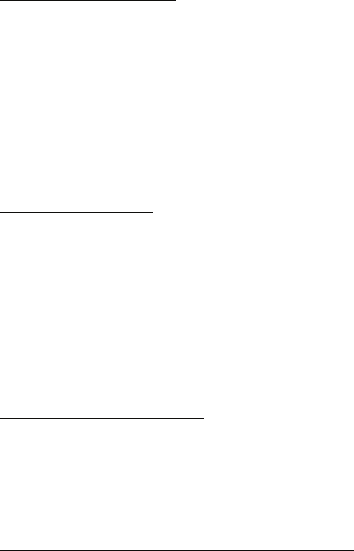
43
application, all compressor relays and related functions will
operate per their associated DIP switch 2 setting on S1.
HEATING STAGE 3 — In Heating Stage 3 mode, the Fan
Enable, Fan Speed and Compressor relays remain on. The EH1
output is turned on immediately. With continuing Heat Stage 3
demand, EH2 will turn on after 10 minutes. EH1 and EH2 are
turned off immediately when the Heating Stage 3 demand is re-
moved. The control reverts to Heating Stage 2 mode.
The output signal EH2 will be off if FP1 is greater than 45 F
AND FP2 (when shorted) is greater than 110 F during Heating
Stage 3 mode. This condition will have a 30-second
recognition time. Also, during Heating Stage 3 mode, EH1,
EH2, Fan Enable, and Fan Speed will be ON if G input is not
active.
EMERGENCY HEAT — In Emergency Heat mode, the Fan
Enable and Fan Speed relays are turned on. The EH1 output is
turned on immediately. With continuing Emergency Heat de-
mand, EH2 will turn on after 5 minutes. Fan Enable and Fan
Speed relays are turned off after a 60-second delay. The control
reverts to Standby mode.
Output EH1, EH2, Fan Enable, and Fan Speed will be ON if
the G input is not active during Emergency Heat mode.
COOLING STAGE 1 — In Cooling Stage 1 mode, the Fan
Enable, compressor and RV relays are turned on immediately.
If configured as stage 2 (DIP switch set to OFF) then the com-
pressor and fan will not turn on until there is a stage 2 demand.
The Fan Enable and compressor relays are turned off immedi-
ately when the Cooling Stage 1 demand is removed. The con-
trol reverts to Standby mode. The RV relay remains on until
there is a heating demand. If there is a master/slave or dual
compressor application, all compressor relays and related func-
tions will track with their associated DIP switch 2 on S1.
COOLING STAGE 2 — In Cooling Stage 2 mode, the Fan
Enable, compressor and RV relays remain on. The Fan Speed
relay is turned on immediately and turned off immediately
once the Cooling Stage 2 demand is removed. The control
reverts to Cooling Stage 1 mode. If there is a master/slave or
dual compressor application, all compressor relays and related
functions will track with their associated DIP switch 2 on S1.
NIGHT LOW LIMIT (NLL) STAGED HEATING — In NLL
staged Heating mode, the override (OVR) input becomes ac-
tive and is recognized as a call for heating and the control will
immediately go into a Heating Stage 1 mode. With an addition-
al 30 minutes of NLL demand, the control will go into Heating
Stage 2 mode. With another additional 30 minutes of NLL
demand, the control will go into Heating Stage 3 mode.
Units with HWR Option
FAN ONLY — A (G) call from the thermostat to the (G)
terminal of the Deluxe D control board will bring the unit
on in fan only mode.
COOLING STAGE 1 — A simultaneous call from (G),
(Y1), and (O) to the (G), (Y1), (O/W2) terminals of the
Deluxe D control board will bring the unit on in Cooling
Stage 1.
COOLING STAGE 2 — A simultaneous call from (G),
(Y1), (Y2), and (O) to the (G), (Y1), (Y2), and (O/W2) ter-
minals of the Deluxe D control board will bring the unit on
in Cooling Stage 2. When the call is satisfied at the thermo-
stat the unit will continue to run in Cooling Stage 1 until the
Cooling Stage 1 call is removed or satisfied, shutting down
the unit.
NOTE: Not all units have two-stage cooling functionality.
HEATING STAGE 1 — A simultaneous call from (G) and
(Y1) to the (G) and (Y1) terminals of the Deluxe D control
board will bring the unit on in Heating Stage 1.
HEATING STAGE 2 — A simultaneous call from (G), (Y1),
and (Y2) to the (G), (Y1), and (Y2) terminals of the Deluxe
D control board will bring the unit on in Heating Stage 2.
When the call is satisfied at the thermostat the unit will con-
tinue to run in Heating Stage 1 until the call is removed or
satisfied, shutting down the unit.
NOTE: Not all units have two-stage heating functionality.
REHEAT MODE — A call from the humidistat/dehumidis-
tat to the (H) terminal of the Deluxe D control board will
bring the unit on in Reheat mode if there is no call for cool-
ing at the thermostat. When the humidistat/dehumidistat call
is removed or satisfied the unit will shut down.
NOTE: Cooling always overrides Reheat mode. In the
Cooling mode, the unit cools and dehumidifies. If the cool-
ing thermostat is satisfied but there is still a call for dehu-
midification, the unit will continue to operate in Reheat
mode.
Units with WSHP Open Multiple Protocol —
The WSHP Open multi-protocol controller will control me-
chanical cooling, heating and waterside economizer outputs
based on its own space temperature input and set points. An
optional CO
2
IAQ (indoor air quality) sensor mounted in the
space can maximize the occupant comfort. The WSHP Open
controller has its own hardware clock that is automatically set
when the heat pump software is downloaded to the board. Oc-
cupancy types are described in the scheduling section below.
The following sections describe the functionality of the WSHP
Open multi-protocol controller. All point objects referred to in
this sequence of operation will be referenced to the objects as
viewed in the BACview
6
handheld user interface.
SCHEDULING — Scheduling is used to start/stop the unit
based on a time period to control the space temperature to spec-
ified occupied heating and cooling set points. The controller is
defaulted to control by occupied set points all the time, until ei-
ther a time schedule is configured with BACview
6
, Field Assis-
tant, i-Vu
®
Open, or a third party control system to enable/dis-
able the BAS (Building Automation System) on/off point. The
local time and date must be set for these functions to operate
properly. The occupancy source can be changed to one of the
following:
Occupancy Schedules
— The controller will be occupied 24/7
until a time schedule has been configured using either Field
Assistant, i-Vu Open, BACview
6
or a third party control system
to enable/disable the BAS on/off point. The BAS point can be
disabled by going to Config, then Unit, then Occupancy Sched-
ules and changing the point from enable to disable then click-
ing OK.
NOTE: This point must be enabled in order for the i-Vu Open,
Field Assistant, or BACview
6
control system to assign a time
schedule to the controller.
Schedule_schedule
— The unit will operate according to the
schedule configured and stored in the unit. The schedule is
accessible via the BACvie w
6
Handheld tool, i-Vu Open, or
Field Assistant control system. The daily schedule consists of a
start/stop time (standard or 24-hour mode) and seven days of
the week, starting with Monday and ending on Sunday. To
enter a daily schedule, navigate to Config, then Sched, then
enter BACview
6
Admin Password (1111), then go to
schedule_schedule. From here, enter either a Weekly or Excep-
tion schedule for the unit.
Occupancy Input Contact
— The WSHP Open controller has
the capability to use an external dry contact closure to deter-
mine the occupancy status of the unit. The Occupancy Sched-
ules will need to be disabled in order to utilize the occupancy
contact input.
NOTE: Scheduling can only be controlled from one source.
BAS (Building Automation System) On/Off
— A BAS
system that supports network scheduling can control the unit
through a network communication and the BAS scheduling
function once the Occupancy Schedules have been disabled.



